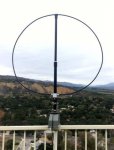ridgescan
Member
My Wellbrook is, as some here know, way up on the roof of the building I live in. It's 50' up. It performs well up there although that kind of height is not ideal for what this antenna's designed for, as it does have more noise up there than I like in HF.
My question is this though: it's on a tripod. It has two masts; one from the tripod to the rotator, and one from the rotator to the loop. For windage, I got a nice plastic-coated pine wood dowel 2 years ago for the tripod-to-rotator run and it's doing very well. But the mast between the loop and the rotator is metal.
If I get that metal mast out and put in another coated wood dowel, ya think this might even slightly improve S/N? I read that the loop performs better if it's sort of made to "float" in the air.
My question is this though: it's on a tripod. It has two masts; one from the tripod to the rotator, and one from the rotator to the loop. For windage, I got a nice plastic-coated pine wood dowel 2 years ago for the tripod-to-rotator run and it's doing very well. But the mast between the loop and the rotator is metal.
If I get that metal mast out and put in another coated wood dowel, ya think this might even slightly improve S/N? I read that the loop performs better if it's sort of made to "float" in the air.


